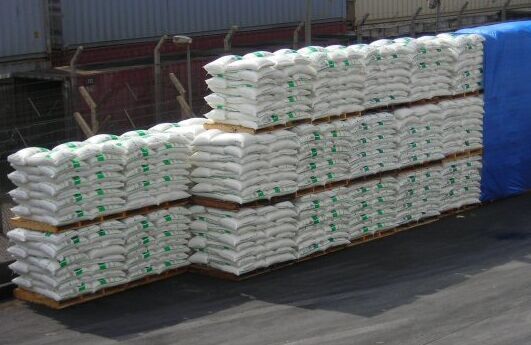2.2 Weaving process
The weaving process of the Polypropylene woven bag is: hanging yarn-threading-starting-lifting-winding-unloading. First, draw the warp yarn from each row of spindles on the warp frame, the warp frame porcelain hole-the first long vertical plate-the pressure roller-the let-off guide roller-the second long vertical plate-the godet roller- Porcelain hole-tension rod-brown wire-round steel buckle-fixed warp ring-reserved cloth base. Load the weft yarn into the shuttle magazine. After the machine is started, the shuttle is driven by the shuttle pushing device to make a circular motion, and the warp yarn supply system and the shuttle pushing device are closely matched to knit into a cylindrical flat woven fabric. The braid is pulled up by the traction device on the top of the loom. After passing through the guide roller, it is wound by the winding device behind the warp frame. When the winding diameter reaches about 1.2 meters, it is unloaded and sent to the next process (usually 24 hours) Next time).
The factors that affect quality during the knitting process include size loops, warp and weft density change gears, and yarn arrangement. Whether the size ring is standard or not directly affects whether the width of the cloth meets the standard. Generally, the error between the circumference of the size ring and the standard cloth width multiplied by 2 is within 3mm; the warp and weft density is mainly controlled by the changing gear, especially the cloth with different wefts. The transformation gear required for the surface is different, and the final measurement standard is the number of inner wires per 100mm. The yarn must be evenly arranged, and the yarn must be uneven, or the yarn may be crossed or entangled, resulting in shrinkage of the cloth surface, unsightly wrinkles, and a large amount of waste.
2.3 Technical indicators of weaving process
2.3.1 Weave density
Knitting density refers to the number of warp and weft yarns in a 100mm×100mm braid. The weaving density and density tolerance are specified in the national standard. The density of commonly used woven cloth is 36×36 pieces/250px, 40×40 pieces/250px, 48×48 pieces/250px.
2.3.2 Mass per unit area of pp woven fabric
The weight per unit area of pp woven fabric is expressed in square meters, which is an important technical indicator of pp woven fabric. The grammage per square meter mainly depends on the warp and weft density and the thickness of the flat wire, which affects the tensile strength and load capacity of the pp woven fabric, which is a major link for the production enterprise to control costs.
2.3.3 Tensile load of pp woven fabric
For woven fabrics, it can bear tensile loads in both warp and weft directions, called warp and weft tensile loads.
2.3.4 Width
The width of various woven fabrics directly affects the bag making process. For tube cloth, the warp is used to express the width; the warp is equal to half of the circumference.
2.3.5 Feel
PP flat wire braid feels thicker, wide, and hard; HDPE flat wire braid feels softer, lubricating and not dense; adding calcium masterbatch to PP flat wire makes the hand feel very broad; less HDPE is added to PP Will make it soft. The flat wire is narrow, the knitting is flat and the hand feels soft; the flat wire is wide, and the cloth is folded more and the hand feels rough.
2.3.6 Printing and cutting
The qualified woven fabric produced in the previous process is printed on the woven fabric with product-related information through a printing machine, and then the bag cutting machine (cutting machine) is cut to a size that meets the needs of the customer. The cutting edge is not allowed to appear scattered, and the national standard does not specify the requirements for printing. Companies should formulate corporate printing standards based on user requirements, while considering their own printing equipment types, printing ink types, and printing capabilities. Since most companies use letterpress printing, corporate printing standards can be formulated by referring to relevant standards and requirements of letterpress printing. In the production of Polypropylene woven bag for food, special attention should be paid to the control of the residual amount of solvents in the ink. Water-based inks are preferred, followed by products with bisphenol components to minimize the residual amount of solvents.
2.3.7 Sewing
The cut woven fabric is made into a Polypropylene woven bag with a sewing machine (sewing machine). In the national standard GB/T8946, the tensile load in the seam direction and the seam bottom direction is specified. The main factors that affect the strength of the suture are the variety and model of the suture, the size of the stitch length, the stitches, the size of the curling or hemming suture to the edge of the bag, and the cutting method. The sewing thread used for sewing is implemented according to the national standard GB/T6836-2007. There are currently two sewing methods for Polypropylene woven bag: one is the sewing method of civilian sewing machines, and the other is the sewing method of industrial sewing machines. Use a civilian sewing machine to sew with a small stitch distance between 2-5mm; use an industrial sewing machine to sew a Polypropylene woven bag with a larger stitch distance, generally between 6-13mm. The effect of different stitch lengths on the seam strength and drop performance of Polypropylene woven bag.
2.3.8 Inspection
The inspection of Polypropylene woven bag complies with the national standard GB/T8946.

3. Conclusion
(1) In the production process of Polypropylene woven bag, the ratio of raw materials is the basis for ensuring product qualification, especially when it comes to food products, raw materials cannot be added with recycled materials; drawing is the most critical link; weaving, printing and sewing are beautiful products An important guarantee, especially food products, has higher requirements for printing.
(2) In the entire production process, the technical parameters and indicators of each process have a direct relationship with the impact of product quality. Strengthening the research on the impact of each technical parameter and index on product quality can better promote production, ensure product quality, and improve corporate competitiveness.








